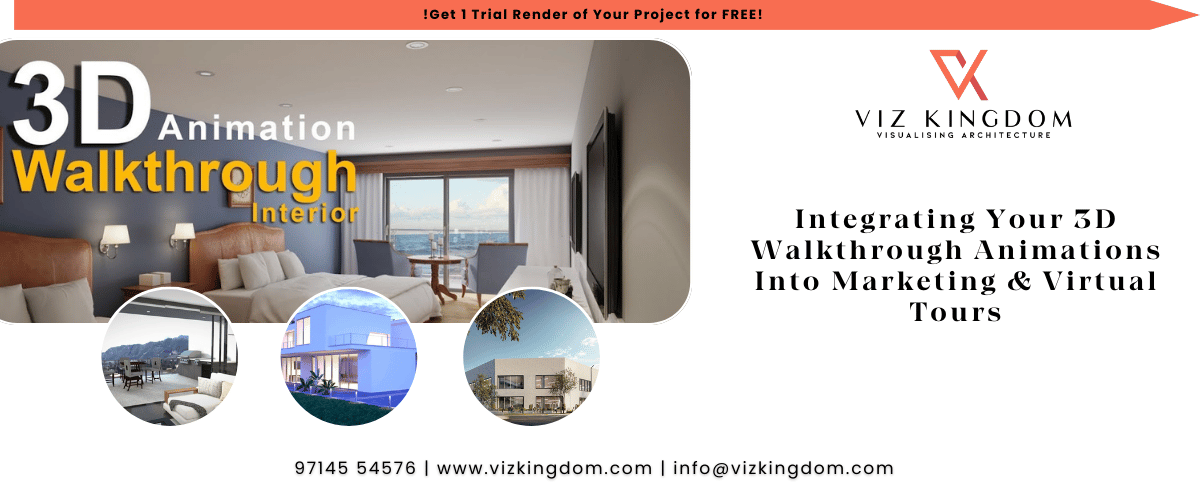
3D Interior Walkthrough – A Game Changer for Interior Design and Real Estate
Imagine walking through a home, office, or hotel suite that hasn’t been built yet—and experiencing every detail from flooring texture to wall lighting. That’s the power of a 3D interior walkthrough. In 2025, these virtual visualizations are more than a design trend—they’re an industry standard. If you’re planning to pitch a design or market a property, working with experienced 3d interior rendering services can help you win client trust, faster approvals, and project clarity.
What is a 3D Interior Walkthrough?
A 3D interior walkthrough is a digitally rendered video or interactive experience that allows viewers to move through an interior space virtually. It replicates real-world navigation—moving through hallways, entering rooms, looking around—all before the actual construction or renovation takes place.
Why 3D Interior Walkthroughs Are Booming in 2025
- 🧑💼 82% of real estate buyers prefer visual walkthroughs over still floor plans.
- 🏡 Interior designers report a 35% faster approval rate using 3D walkthroughs.
- 🌍 Increased demand for remote collaboration has made virtual tours a must-have tool.
Key Benefits of 3D Interior Walkthroughs
Clear communication with clients
It bridges the gap between design intent and client understanding, reducing the chance of misinterpretation.
Early decision-making
Clients can evaluate finishes, furniture placements, and lighting before execution.
Time and cost saving
Changes made in the virtual stage save real-world rework costs.
Enhances marketing and presentations
Real estate firms use it to boost engagement across websites, ads, and presentations.
Who Uses 3D Interior Walkthroughs?
| Industry | Application |
| Interior Design | Home, commercial, hospitality interiors |
| Architecture Firms | Client project approvals and design reviews |
| Real Estate | Virtual tours of apartments, villas, and offices |
| Furniture Brands | Showcasing layouts with their products |
| Retail & Hospitality | Designing store layouts, hotel suites, and salons |
How a 3D Interior Walkthrough is Created – Step-by-Step
Step 1: Designing or importing the model
Start with a CAD plan or create a 3D model using tools like SketchUp, Revit, or Chief Architect.
Step 2: Creating the interior elements
Add furniture, textures, materials, and lighting schemes to bring the scene to life.
Step 3: Setting up the walkthrough camera path
Define a smooth path through the space. This simulates a real-time walk-through experience.
Step 4: Rendering the animation
High-quality software like Lumion, 3dsMax, or Unreal Engine is used to render the frames.
Step 5: Post-processing
Color grading, effects, and background music enhance the final video for client delivery.
Best Software for 3D Interior Walkthroughs
- Foyr Neo: AI-powered and beginner-friendly
- Chief Architect: Ideal for floor plan-based walkthroughs
- Blender: Open-source, powerful, and customizable
- Unreal Engine: For hyper-realistic, game-like walkthroughs
- Enscape: Realtime rendering integrated with Revit or SketchUp
- 3dsMax: Photo realistic results, can handle complex projects and wide range of library
Why 3D Interior Walkthroughs are a Game-Changer for U.S. Businesses
In the fast-paced world of U.S. real estate and interior design, 3D interior walkthroughs are revolutionizing how properties and designs are presented. The impact is particularly noticeable in cities like New York, Los Angeles, and Miami, where the real estate market is competitive and fast-moving. According to a 2023 National Association of Realtors (NAR) survey, 73% of homebuyers report that they prefer properties with 3D virtual tours to help them visualize the space before visiting in person.
Save Time, Close Deals Faster
For real estate agents and developers, time is money. Traditional methods of showcasing a property — from static photos to lengthy walk-throughs — can lead to long sales cycles. However, 3D interior walkthroughs streamline the process. A study by Zillow found that listings with 3D tours receive more than 50% more views than those without. U.S. real estate professionals who embrace 3D technology can showcase their properties more effectively and close deals faster.
Real-World Example: How 3D Walkthroughs Helped a U.S. Real Estate Firm
Take the case of Sotheby’s International Realty in New York, which started using 3D interior walkthroughs for high-end apartment listings. By offering virtual tours that allowed potential buyers to explore every detail, from the living room to the kitchen, the company saw a 35% increase in client engagement and reduced in-person showings by 40%. This gave agents more time to focus on qualified buyers and significantly shortened the time it took to close sales.
Benefits for U.S. Interior Designers and Architects
The rise of virtual collaboration in the U.S. due to COVID-19 has also fueled the demand for 3D interior walkthroughs. Interior designers can now present their designs to clients across the country, without the need for travel or face-to-face meetings. U.S.-based architects can also use 3D walkthroughs to gain quicker client approvals for designs, as they can showcase the project in its entirety before construction begins.
For instance, an interior design firm in Los Angeles used 3D walkthroughs to pitch a hotel renovation project to a client in Chicago. The virtual experience allowed the client to walk through the proposed design and make real-time changes, which led to faster approval and a smoother process.
Cost Savings and Increased ROI for U.S. Businesses
While the upfront cost of 3D walkthrough services can seem like an investment, the long-term benefits are undeniable. U.S. businesses can save money by reducing the need for physical prototypes, mockups, or endless revisions to traditional designs. With 3D walkthroughs, clients can see exactly what the final product will look like, significantly reducing the chance of misunderstandings or costly changes during construction.
A Competitive Edge in a Crowded Market
In a crowded U.S. real estate market, 3D walkthroughs provide a unique selling proposition (USP). Offering a highly interactive and engaging way to experience a property or design sets your business apart. It helps build trust with clients, providing a clearer picture of the design while enhancing their overall experience.
The Future of Interior Visualization is Walkable
As AR/VR technology becomes more accessible, interactive interior walkthroughs will merge with virtual reality, allowing clients to “step into” a space using headsets or mobile apps.
Professionals offering 3d architectural rendering services are already upgrading their workflows to stay ahead of the curve.
Tips for an Effective 3D Interior Walkthrough
- Keep the camera motion smooth and realistic
- Focus on lighting – it makes or breaks realism
- Match materials closely to what will be used onsite
- Use post-processing subtly—don’t overdo effects
- Always share a storyboard or sample video with the client for approval
Final Thoughts
A 3D interior walkthrough isn’t just a visual—it’s a sales, communication, and execution tool. Whether you’re pitching a design, closing a deal, or finalizing client approvals, these walkthroughs provide unmatched clarity and confidence.
If you’re ready to impress clients and elevate your design game, consider working with expert 3d interior rendering services that bring life to your ideas—frame by frame.
FAQs – 3D Interior Walkthrough
Q1. What is the difference between a 3D walkthrough and a 3D interior walkthrough?
A 3D interior walkthrough focuses solely on the indoor spaces, while a general walkthrough may include exteriors or aerial views.
Q2. Can I view a 3D interior walkthrough on mobile or VR?
Yes, final videos can be optimized for mobile, and some formats are compatible with VR headsets.
Q3. How long does it take to create a 3D interior walkthrough?
Depending on project size and detail, it can take a few days to two weeks.
Q4. Do I need to provide a floor plan or model?
It helps. You can share a CAD drawing or basic sketch—most studios will convert it into 3D.
Q5. What file format is the final walkthrough delivered in?
Usually in MP4 or MOV format, suitable for presentations, ads, or social media sharing.



